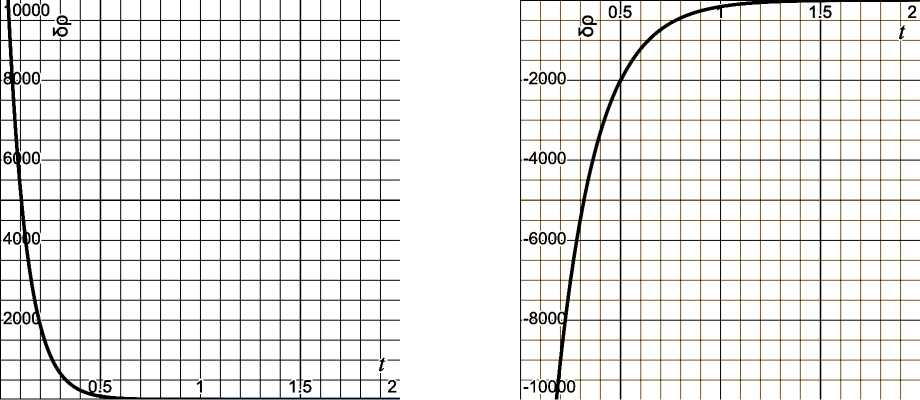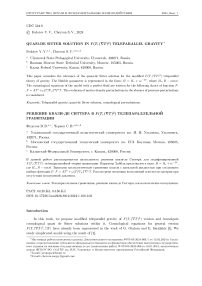Quasi-de Sitter solution in F(T, (T )2) teleparallel gravity
Автор: Fedotov V.V., Chervon S.V.
Журнал: Пространство, время и фундаментальные взаимодействия @stfi
Статья в выпуске: 1 (46), 2024 года.
Бесплатный доступ
This paper considers the relevance of the quasi-de Sitter solution for the modified 𝐹(𝑇, (∇𝑇)2) teleparallel theory of gravity. The Hubble parameter is represented in the form: = 𝐻* + 𝜖𝑒-𝐵𝑡, where 𝐻*,𝐵 - 𝑐𝑜𝑛𝑠𝑡. The cosmological equations of the model with a perfect fluid are written for the following choice of function 𝐹: = 𝐴𝑇𝑛+𝜔(𝑇)∇𝜇𝑇∇𝜇𝑇. The evolution of matter density perturbations in the absence of pressure perturbations is considered.
Teleparallel gravity, quasi-de sitter solution, cosmological perturbations
Короткий адрес: https://sciup.org/142241060
IDR: 142241060 | УДК: 524.8 | DOI: 10.17238/issn2226-8812.2024.1.100-103
Текст научной статьи Quasi-de Sitter solution in F(T, (T )2) teleparallel gravity
In this work, we propose modified teleparallel gravity of F(T, (VT)2) version and investigate cosmological quasi de Sitter solutions within it. Cosmological equations for general version F(T, (VT)2, ПТ) have already been represented in the work of G. Otalora and E. Saridakis [1]. We study simplicated model using the result of [1].
Настоящая работа выполнена в рамках Дополнительного соглашения №073-03-2024-060/1 от 13.02.2024 к Соглашению о предоставлении субсидии из федерального бюджета на финансовое обеспечение выполнения государственного задания на оказание государственных услуг (выполнения работ) № 073-03-2024-060 от 18.01.2024, заключенным между ФГБОУ ВО «УлГПУ им. И.Н. Ульянова» и Министерством просвещения Российской Федерации.
-
1. Cosmological equations
Modified teleparallel gravity with higher derivatives with respect to the torsion scalar of the form F(T, (VT)2, ПТ) was constructed in [1]. The action of the model has the form: s = 2 /d4,eF (T (VT )2, □?)+ sm(e^, Фт), where T is the torsion scalar, e = "е^е^) = ^-ž tetrad de terminant, (VT )2 = rjAB e;e£ V^T V” T = 严VMTV”T. □T = VMVMT. Фт a general field of matter. A\e consider a truncated version F (T, (VT )2) in the Friedmann- Rob er t son-AValker me trie:
曲2 =近2 - q2⑴心, dxldx^,⑵ which arises from the tetrad e^ = d,@g(1, q(。,q(。,q(。), where q = q(。is the scale factor.
The dynamic equations for the cosmological model with a perfect fluid [1] for truncated F(T, (VT)2) model are the following:
Ft Я2 + 24H2Fy (3ЯЯ + Я) Я + 24H3 方Fx + —=迎,(3 )
ҒТЯ + "FT + 24Я [2ЯЯ + 3(Я + Я 2)Я]Ғу + 24Я 2ҒуЯ ⑶ + 24Я 2Я—х + 24—хЯ 2 (12Я2 + Я)+
+24ЯҒх (4Я + 3Я2 )Я = - ^,(4)
where X = (VT)2 : T = -6Я2 : T = 零 =Т2ЯЯ : X = T2 = 144Я 2Я 2, Ғх = 装. Hereinafter wo omit the index m for density pm and pressure 9m , -
By analogy with investigation of /(—, ( ▽冗 )2) [2] we choose the function Ғ(T, (VT)2) as
Ғ = ATn + ^(T)X, A> 0, A = con^t.(5)
An exponent of torsion scalar n is a natural number.
The derivatives of the function Ғ(T, (VT)2) with respect to T, X and time t are
Ft = AnT " -1 + 3TX, F t = An(n - 1)T " -2T + 3TTTX + 3TX,
—Х = 3(T), —X = 3tT = 3T, —Х = 3ttT + 3tT.(6,)
Here we are using abbreviated notation 3T = 岩 ,зтт = ^T2 and so on.
Substituting the relations above into equations of cosmological dynamics (3) and (4) we get:
(AnT "- 1 + 3Tx )Я2 + 24Я 3з(3ЯЯ + Я) + 24Я 3Я3T T + AT ” + 3X = 迎,⑺
12 6
(AnT"-1 + 3 t X)Я + Я(An(n - 1)T"-2T + 3 tt XT + 3 t X ) + 24Я(2ЯЯ + 3(Я + Я2)Я)3TT+ + 24Я 2Я(зTTT 2 + 3TT) + 24Я 2Я ⑶ 3 + 24зЯ2(12Я2 + Я) + 24Яз(4Я + 3Я 2)Я = - 9m. (8)
To solve the field equations (7) and (8), it is necessary to choose the values of the Hubble parameter.
In present work, as an example, let us consider the quasi-de Sitter model.
Let us represent quasi-de Sitter model in the following form:
Я = Я* + ee-B* q = Q0 exp ^Я*t - *e-B),
⑼
where e 《 1, Я*, В - const. and Я*, В > 0.
In our case, the Hubble parameter contains zero and first order parts with respect to infinitesimal parameter e. Therefore we represent the density and pressure in the same manner: p = Po + ebp, 9 = 90 + eb”
-
2・ Solutions for zeroth and first order perturbations in e
Taking into account quasi-de Sitter model (9) with H = H * + ee-Bt and its derivatives H = -еВе - Bt, H = eB2e"Bt, we can derive equations for zeroth and first order perturbations in e. By substituting H( 力 )from (9) into equations (7) - (8), and taking into account , T = 12H* eBe ~ Bt , X = ( 力 )2 = O(e2), T2 = O(e) we obtain the equations on the density and pressure up to first order in e:
12AnH2^n ~ 1 + 36AnH * ee-Bt£ n ~ 1 + 2883H3eBe-Bt(B - 3H*) + Af 〃 = 2(p° + ebp 他 ), (П)
2AnBee ~ Bt^n - 1 + 4Amm - 1)ee"Btfn"1 - 483H2B3ee-Bt - 144H3В2ee-Bt = po + ebp, (12) where £ = -6H2, £ < 0.
Next, extracting zero-order term from obtained equations we find the following relations for the density po and pressure po of the matter :
A 口 (1 - 2 九) =2po, po = 0. (13)
Note, there is no vacuum solution due to absence of possibility to set po = 0 without setting A = 0. Also, let us mention that for odd 几 we have phantom type model po < 0, or in scalar field representation 2 j2< -V (0). So if V (0) > 0 kinetic temi should be negative.
Considering the first order of smallness with respect to e from equations (11) and (12), we obtain expressions for the density perturbations bp and pressure bp:
bp = 18AmH*e-Bt£n"1 + 1443H3Be-Bt(B - 3H*),(14)
bp = 2Ane~Bt£n-1 (B + 2九-2) - 48H2B2e-Bt(3B - 3H*).(15)
From equation (15), for the case of zero pressure perturbation bp = 0 we express 3 :
-
3 = ŽT^ [B + 2(n - 1)] £n-2 + ~ET.
4BB
Then we substitute this expression into the density perturbation equation (14) and obtain the dependence of the density perturbation on time in the absence of pressure perturbation:
bp = e-Bt (12£2(B - 3H*) + AnH*£n-1 19 + 2s J - 3£ - 6(,1)£ ) .(17)
Now we can construct graphs of the dependence the density perturbation on time in the absence of pressure perturbation.

a) b)
Fig. 1. Graph of the dependence 6p ⑴ for a) odd n values and b) even n values
As we can see, the perturbation of density exponentially decreases over time, which can be clearly observed in the graphs. In both cases, the perturbation of density decreases and always tends towards zero. The construction of these graphs is only possible when n e N, and depending on the parity of its value. The behavior of the perturbation of density will tend from positive or negative values towards zero. Regardless of the parameters introduced for the following positive constants "*,A, and g, their influence on the dependency is insignificant.
Conclusion
Thus, we considered a truncated model of the form F(T, (VT)2) = ATn + ®(T)X and showed that in the presence of cosmic dust (po = 0, 8p = 0) there is a stable quasi-de Sitter solution of the form H = H* + E£-B*. Pure de Sitter solution (13) is allowed also. Investigated model belongs to the class of eternal inflation.
Список литературы Quasi-de Sitter solution in F(T, (T )2) teleparallel gravity
- Otalora G., Saridakis E. Modified teleparallel gravity with higher-derivative torsion terms. arXiv, 2016. https://arxiv.org/abs/1605.04599.
- Chervon S., Nikolaev A., Mayorova T., Odintsov S., Oikonomou V. Kinetic Scalar Curvature Extended 𝑓(𝑅) Gravity. arXiv, 2018. https://arxiv.org/abs/1810.01900.


